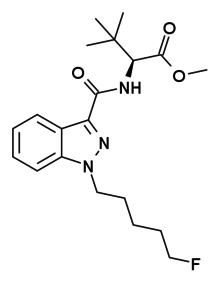 | |
| Legal status | |
|---|---|
| Legal status |
|
| Identifiers | |
| |
| CAS Number | |
| PubChem CID | |
| ChemSpider | |
| UNII | |
| KEGG | |
| CompTox Dashboard (EPA) | |
| ECHA InfoCard | 100.257.468 |
| Chemical and physical data | |
| Formula | C20H28FN3O3 |
| Molar mass | 377.460 g·mol−1 |
| 3D model (JSmol) | |
| |
| |
5F-ADB (also known as MDMB-5F-PINACA[2] and 5F-MDMB-PINACA) is an indazole-based synthetic cannabinoid from the indazole-3-carboxamide family, which has been used as an active ingredient in synthetic cannabis products and has been sold online as a designer drug.[3][4] 5F-ADB is a potent agonist of the CB1 receptor,[5] though it is unclear whether it is selective for this target. 5F-ADB was first identified in November 2014 from post-mortem samples taken from an individual who had died after using a product containing this substance. Subsequent testing identified 5F-ADB to have been present in a total of ten people who had died from unexplained drug overdoses in Japan between September 2014 and December 2014. 5F-ADB is believed to be extremely potent based on the very low levels detected in tissue samples, and appears to be significantly more toxic than earlier synthetic cannabinoid drugs that had previously been sold.[6]
In 2018, 5F-ADB was the most common synthetic cannabinoid to be identified in Drug Enforcement Administration seizures.[7] 5F-ADB was also identified in cannabidiol (CBD) products from a US-based CBD manufacturer in 2018.[8]
- ^ Anvisa (2023-07-24). "RDC Nº 804 - Listas de Substâncias Entorpecentes, Psicotrópicas, Precursoras e Outras sob Controle Especial" [Collegiate Board Resolution No. 804 - Lists of Narcotic, Psychotropic, Precursor, and Other Substances under Special Control] (in Brazilian Portuguese). Diário Oficial da União (published 2023-07-25). Archived from the original on 2023-08-27. Retrieved 2023-08-27.
- ^ Pulver B, Fischmann S, Gallegos A, Christie R (March 2023). "EMCDDA framework and practical guidance for naming synthetic cannabinoids". Drug Testing and Analysis. 15 (3): 255–276. doi:10.1002/dta.3403. PMID 36346325.
- ^ Shevyrin V, Melkozerov V, Nevero A, Eltsov O, Shafran Y, Morzherin Y, et al. (August 2015). "Identification and analytical characteristics of synthetic cannabinoids with an indazole-3-carboxamide structure bearing a N-1-methoxycarbonylalkyl group". Analytical and Bioanalytical Chemistry. 407 (21): 6301–6315. doi:10.1007/s00216-015-8612-7. PMID 25893797. S2CID 31838655.
- ^ Giorgetti A, Brunetti P, Pelotti S, Auwärter V (October 2022). "Detection of AP-237 and synthetic cannabinoids on an infused letter sent to a German prisoner". Drug Testing and Analysis. 14 (10): 1779–1784. doi:10.1002/dta.3351. PMC 9804899. PMID 35918775. S2CID 251281159.
- ^ Banister SD, Longworth M, Kevin R, Sachdev S, Santiago M, Stuart J, et al. (September 2016). "Pharmacology of Valinate and tert-Leucinate Synthetic Cannabinoids 5F-AMBICA, 5F-AMB, 5F-ADB, AMB-FUBINACA, MDMB-FUBINACA, MDMB-CHMICA, and Their Analogues". ACS Chemical Neuroscience. 7 (9): 1241–1254. doi:10.1021/acschemneuro.6b00137. PMID 27421060.
- ^ asegawa K, Wurita A, Minakata K, Gonmori K, Yamagishi I, Nozawa H, et al. (2014). "Identification and quantitation of 5-fluoro-ADB, one of the most dangerous synthetic cannabinoids, in the stomach contents and solid tissues of a human cadaver and in some herbal products". Forensic Toxicology. 33: 112–121. doi:10.1007/s11419-014-0259-0. S2CID 45508189.
- ^ "Emerging Threat Report: Annual 2018" (PDF). Special Testing and Research Laboratory, Drug Enforcement Administration. Archived from the original (PDF) on 2019-08-01. Retrieved 2019-08-01.
- ^ Poklis JL, Mulder HA, Peace MR (January 2019). "The unexpected identification of the cannabimimetic, 5F-ADB, and dextromethorphan in commercially available cannabidiol e-liquids". Forensic Science International. 294: e25–e27. doi:10.1016/j.forsciint.2018.10.019. PMC 6321772. PMID 30442388.